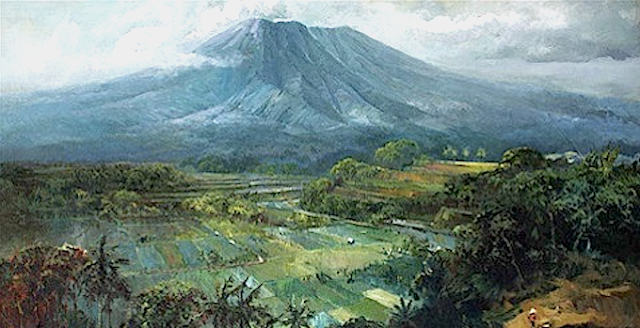%20%20DIeng%20Platea-%20Dieng%20Complex-%20%20In%20%20_voorstellend_de_tempel_Candi_Bima_op_het_Diengplateau_T1912-%20Tropenmuseum%20.jpg)
Dieng Plateau (2,565m)
Indonésie (Java)
In Voorstellend de tempel Candi Bima op het Diengplateau, Huile sur toile, 1912, Tropenmuseum
Le plateau volcanique
Le plateau de Dieng qui culmine à 2 565 mètres d'altitude est situé en Indonésie, dans le centre de Java, au nord-ouest du Sumbing, un volcan, et au nord de la ville de Wonosobo. Le plateau est constitué d'une caldeira mesurant quatorze kilomètres de longueur dans le sens est-ouest pour six kilomètres de largeur. Le fond de la dépression s'élève entre 1 600 et 2 000 mètres d'altitude. Ce volcan est encore actif avec d'importantes émissions de gaz volcaniques sulfurés formant des fumerolles, des mares de boue et des lacs acides. Sa dernière éruption remonte au 27 septembre 2009. La caldeira renferme une vingtaine de cônes volcaniques, cinq cratères, quatre dômes de lave et dix champs de fumerolles et mares de boue. Le climat y est plus humide que dans les plaines environnantes avec une plus forte pluviométrie et de fréquentes brumes. Ce climat combiné aux sols volcaniques fertiles ont permis le développement de l'agriculture dans le fond et sur les pentes de la caldeira. Intensément peuplé le plateau constitue un site archéologique avec la présence de huit temples hindouistes en ruine. Les plus anciennes constructions du plateau de Dieng sont représentées par huit temples hindouistes datant des 7e et 8e siècles. Leur nombre original se situait autour de 400. Ces temples en pierre sont de petite taille et plutôt simples comparés à des édifices plus récents comme les temples de Borobudur et de Prambanan. Ils étaient dédiés à des divinités ancestrales mais n'avaient pas vocation à servir de lieu de culte aux hommes.
Richard Paul Max Fleischer était un peintre et bryologue allemand. Dans le domaine de la botanique, son nom est associé à son travail sur les mousses de Java. ll suivit des cours d'art à Breslau et obtint son diplôme de professeur d'art en 1881. Il poursuivit ses études à Munich et à Paris, où son intérêt pour les sciences naturelles s'amplifia. Il s'installa ensuite à Zurich en 1892 pour étudier la géologie Dans la dernière partie des années 1890, il fut invité par le botaniste Melchior Treub à Java comme 'illustrateur. Parallèlement à ses fonctions artistiques, il collecta des spécimens régionaux et mena des recherches sur les mousses de l'île. Durant son séjour aux Indes orientales néerlandaises, il apprit également la technique de création d' imprimés batik à partir de teintures végétales. Après plusieurs années passées à Java, il voyagea en Nouvelle-Guinée, dans l' archipel Bismarck, en Australie en Nouvelle-Zélande et en Amérique du Sud avant de retourner en Allemagne en 1903. De 1908 à 1913, il revisite l'Asie du Sud-Est maritime , où il collectionne surtout des bryophytes mais aussi orchidées et champignons de Java. En 1914, il commença à travailler au musée botanique de Berlin et trois ans plus tard, il fut nommé professeur de botanique à l' Université de Berlin . En 1925, il se rendit aux îles Canaries pour peindre et étudier les mousses de la région. Au cours de l'année suivante, il s'installe à La Haye et, en 1927 il retourna aux Canaries. Après sa mort en 1930, ses collections privées et sa bibliothèque furent achetées par un antiquaire de Leipzig.
2023 - Wandering Vertexes ....
Errant au-dessus des Sommets Silencieux...
Un blog de Francis Rousseau
-%20Indonesian%20mountians.JPG)

















